- Introduction
- Changes from previous Sharp units
- Import Warning
- Appearance and Design
- General Design
- Available Colors
- Size/Build
- Buttons
- Input/Output Jacks
- Line Out
- Input/Output Specs
- Display Window
- Loading/Eject Mechanism
- Included Accessories
- Display
- Display Window
- Display Indicators - Level Meter
- Display Modes
- Text Scrolling Smoothness
- Battery Details
- Battery Type
- Battery Life
- Recharging Procedure - "Refresh" System
- External Battery Pack
- Sound Quality
- Sharp Sound vs Sony Sound vs...
- Bass Boost Settings / Bass Distortion
- Included Earbuds
- Remote Control
- Ergonomics & Remote Design
- Available Functions
- Remote Backwards Compatibility
- Remote Display/Backlight
- Display Modes/Capabilities
- Headphone Jack Location
- Playback and General Operation
- General Playback
- Turning On/Shutting Off
- Changing Tracks
- Playback Functions/Modes
- FAST Playback
- Track Access and Read/Write Times Times
- Fast Forward/Rewind Smoothness
- Smooth Music Loops & Seamless Transitions
- Auto Play
- Motor Noises (or lack of!)
- Anti-Shock Memory
- Pulling out the DC plug during playback
- Recording
- General Recording Notes
- MP3-to-MD Recording - PC Link Option
- END SEARCH?
- Switching Recording Modes
- Recording Immediately After Changing Discs
- Adjusting Recording Levels & Automatic Gain Control
- Synchro Recording
- Auto Track Mark Modes
- Time/Date Stamp (or lack of)
- LP Stamp
- Pulling the plug during Recording
- Editing
- Editing During Playback/Recording, Edit Menus
- Dividing Tracks
- Disc/Track Titling
- Name Stamp
- TOC updates (and how to cancel them)
- Setup Menu Options
- BEEP
- Auto PLAY
- POWER SAVE
- Digital Level MODE
- LIGHT
- Links / Contact
|
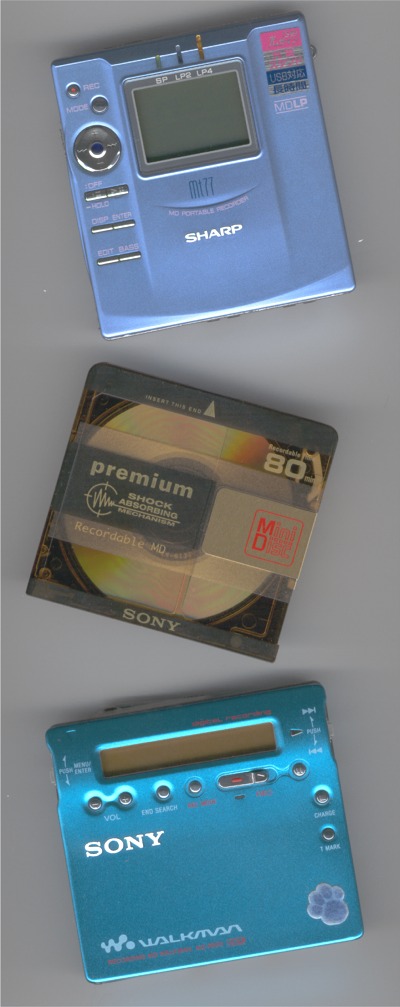
|
|
Introduction | Back to TOC
|
|
If you're in the market for a new minidisc unit and are relatively new to the MD format, you're probably wondering what the best unit on the market is. The short (and long) answer to that is that there is no one perfect MD unit out there. Different units (from different brands) all have different subsets of features, and--most likely--no single model will have absolutely everything you're looking for. Some people naively assume that since Sony developed the MD format, it would follow that Sony units are the best... and this isn't always the case (although it may hold true depending on your needs). Sharp units are generally known for having stronger audio outputs, but they also have their drawbacks (don't allow you to edit tracks during playback, among other things). The MT77 is a very good unit, but in terms of improvement over the previous generation (the 831), Sharp really didn't make as many improvements to this generation as Sony did with the R900 (although you could easily argue that Sony probably needed to make more improvements to the R90 than Sharp did to the 831). Really the only significant addition is MDLP... and if you don't know much about MDLP, check out the minidisc.org MDLP FAQ.
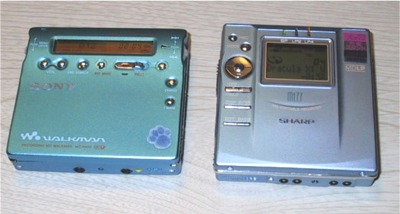
The Sony MZ-R900 and Sharp MD-MT77, side-by-side
The MT77 was released in Japan in November 2000, and has already made its way into the European market as the MT877. UK residents have already seen the release of the R900... (lucky Brits ^_^) The US model of the MT77 (called the MT877) is scheduled for release in the US in late May 2001 [Click here to read the Sharp press release]. For reference, the Sony MZ-R900 was released in Japan in September 2000, but won't make its US release until July 2001 (a 10 month delay?!?).
If you're wondering where you can buy the MT77, it is available from a number of places. I bought mine from Japan-Direct [www.japan-direct.com]. I have dealt with them numerous times and their service is exceptional. If you are planning on importing the MT77 (or any imported MD unit), I would strongly advise ordering from a retailer that will aid you with any warranty claims, as this is a must if you are not native to the Japanese tongue.
This is the third major review page I've done, and those of you familiar with my previous pages should be familiar with the layout. You can see the complete list of topic headers above, along with a list of subtopics under each header... just click on the header that you want to go to. This is basically the table of contents for this page. Most of you know how detailed I am, and there is a lot of info here. I did think about splitting up this page into a series of separate pages (by topic), and linking them together, but I decided against this, as I really wanted all of this to be on one contiguous page. Hopefully you will find this page informative, especially if you are in the market to purchase a new MD player. If you want to read my previous reviews, I have done review pages on the Sony MZ-R900, and before that, a comparison page between the Sony MZ-R90 and Sharp MT831). And if you need to read more user opinions of the MT77, check out the T-station (www.t-station.net). They have a few user reviews of the MT77 (and many other MD units)... however some of the reviews there need to be taken with a grain of salt, as you will probably see for yourself. However some of them might provide some useful insight, as my page can't possibly cover all the angles. Also try the Minidiscussion Message Boards if you're looking for a good discussion forum.
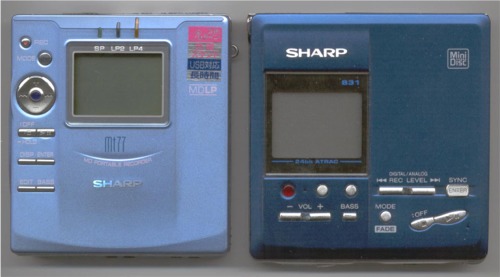
The Sharp MT77 sitting next to last year's MT831
 Changes from previous Sharp models
Changes from previous Sharp models
Aside from adding MDLP compatibility, the MT77 is not significantly different from previous Sharp units. The most significant changes Sharp has made from the 831 are the addition of the INTRO PLAY mode and the removal of the fader, and even those are fairly minor changes. You've also got the LED's at the top and the two-line display, but they add almost nothing in terms of functionality. Sharp has moved to a nickel-metal hydride rechargeable battery, and the MT77 cannot be charged during operation. While both the 831 and MT77 use recharging stands, the MT77 does not have a DC jack on the main unit. Aside from these minor changes, the MT77 is not really a significant upgrade (not nearly as big of an improvement as the Sony R900 was from the R90). Still, the MT77 has the same advantages that all Sharp units have over their Sony counterparts, so if you're a perennial Sharp user it's worth a look. The one thing that really amazes me about the MT77 is the lack of any motor noise. During operation, the MT77 is almost silent (much quieter than the R900), which is something Sony could definitely take some notes on. Another operational improvement Sharp has made on the MT77 is that digital synchro recording works properly when recording from the optical output of a computer's soundcard--almost all portable MD recorders previous had problems with this.
 Import Warning!
Import Warning!
As of this writing (March 2001), the MT77 is not yet available in the US, so if you are importing this unit, please get either a power converter suitable for your country (some e-tailers--Japan-Direct and HyperJack, to name a couple--will sell you one with your MD purchase), or go to a local electronics store and buy a suitable adapter. The outputs for the MT77's adapter is 5V DC, 800mA. Unfortunately, 5V adapters are not very easy to find, so you may have trouble finding one. I don't recommend using the 100V Japanese adapter on a 120V US outlet (the unit will get VERY hot), although some people will do it anyway. Some retailers will ignorantly tell you that an imported MD unit will work "perfectly" when running a 100V adapter on a 120V outlet... and while it is true that most electronics are designed to tolerate a range of input voltages, they are not really designed to constantly operate on a higher voltage level (for reference, if you run a 100V AC adapter on a 120V outlet, a 5V adapter will output roughly 8V DC). And aside from actually operating the MD unit, you will almost certainly run into issues with recharging the battery if you are not using and adapter with the correct voltage. If you want to be safe, get a power converter or use a proper adapter.
The rechargeable battery is exactly the same as the Sony NH-14WM, so if you happen to have a spare Sony charger, you can use that to charge the battery. Or if you have bought a Sharp MD unit in the past that came with a 5V adapter for your territory, just use that.
Also, if you are planning on importing the MT77 (or any other MD unit) from Japan via the Internet, pay attention to retailers' warranty policies. Should you unforeseeably have your imported MD unit break down due to defect... Japanese MD units typically come with a one-year Japanese warranty, and some e-tailers will take care of any warranty issues with the manufacturer for you... although this usually requires you to send your unit back to Japan. On the other hand, some e-tailers will just stick you with a lemon... and that sucks. If you've never imported before... do your homework and make sure any e-tailer you're considering is reputable. Should anyone be curious, at the bottom of this page, I put together a small list of e-tailers that I have dealt with (and have had mostly good experience with). Everyone's experiences may be different but... if you do your research, you should be okay.
|
|
Appearance and Design | TOC
|
Quick Pros and Cons
Pretty looking unit, with a nice large display window. But the tiny buttons and poor button spacing/layout might turn you off. The recharging cradle is a nice touch, but there is no DC jack on the main unit. The MT77 is virtually the same size as the MZ-R900.
|
|
 General Design
General Design
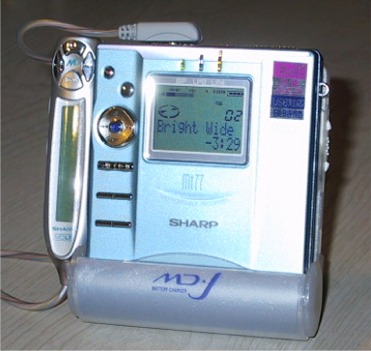 Sharp has given the MT77 a very slick design that most people either love or hate. As usual, the unit looks smaller in person that it does in photos and snapshots. The display window is nice and large, and has a two-line text display, which is a nice addition (unfortunately Sharp did not implement this as well as they could have, as only the 2nd line can be changed by the user, and the first line ALWAYS shows the disc name). All of the buttons are aligned on the left side of the face, and as you can probably see, the buttons are small. Normally I am not one to complain about the size of buttons on portables (I thought the size of the buttons on the R55 and R900 were just fine), but the buttons on the MT77 are small and not spaced out very well. The unit opens on the left edge, which is where the disc is inserted (a bit awkward unless you're left-handed). The door must still be pulled open after you slide the eject lever--no "one-touch eject" on the Sharps just yet... Input/output jacks are on the top edge, while the rechargeable battery hatch and external battery case connections are on the bottom edge of the main body. There is nothing on the right-hand edge save for the small metal loop for an optional hand strap (not included with the MT77 strangely).
Sharp has given the MT77 a very slick design that most people either love or hate. As usual, the unit looks smaller in person that it does in photos and snapshots. The display window is nice and large, and has a two-line text display, which is a nice addition (unfortunately Sharp did not implement this as well as they could have, as only the 2nd line can be changed by the user, and the first line ALWAYS shows the disc name). All of the buttons are aligned on the left side of the face, and as you can probably see, the buttons are small. Normally I am not one to complain about the size of buttons on portables (I thought the size of the buttons on the R55 and R900 were just fine), but the buttons on the MT77 are small and not spaced out very well. The unit opens on the left edge, which is where the disc is inserted (a bit awkward unless you're left-handed). The door must still be pulled open after you slide the eject lever--no "one-touch eject" on the Sharps just yet... Input/output jacks are on the top edge, while the rechargeable battery hatch and external battery case connections are on the bottom edge of the main body. There is nothing on the right-hand edge save for the small metal loop for an optional hand strap (not included with the MT77 strangely).
One thing to notice is that there is no DC jack on the main unit (although you can run the unit off of the AC adapter by putting it in the cradle). Perhaps in Sharp's efforts to miniaturize, they had to leave this off (?). If you like using your MD unit in the car this can be a pain. To recharge the battery you can use the recharging cradle, which is where the AC adapter plugs into. There are three colored LED (light emitting diodes) above the display window on the top of the face, which [among other things] light up to indicate the current record/playback format [ie, SP, LP2, LP4]. These lights also go off when changing tracks and during other operations, and the operation of the lights can be changed in the setup menu (if you think they're silly, you can just turn them off).
 Colors
Colors
The MT77 is available in two colors, blue and silver. The blue model is the one I have and has a pale, iridescent touch (the color is borderline feminine). As far as I know, the blue color is only available as a Japanese import. The UK model is [so far] only available in silver, and the US model will only be available in silver when it is released here in May. With the blue model, the color looks different depending on the angle that you view it from. Comparing it to the blue colored R900, the MT77 generally looks a lighter blue, but at certain angles, it appears to be darker.
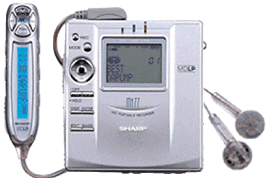
Press photo of the silver MT77
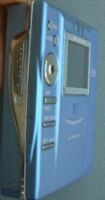 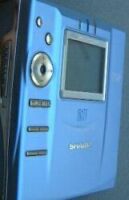 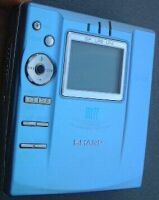
Three shots showing off the iridescent finish of the blue MT77
 Size/Build
Size/Build
The minimal measurements of the MT77 are 71.9 x 16.8 x 78.7 mm. This is roughly the size of two minidiscs in their slip cases, stacked on top of each other. The minimal measurements of the rival Sony MZ-R900 are 72 x 17.1 x 78.9 mm. Both units have protrusions which would cause the measurements to be slightly larger. In reality the MT77 and R900 are almost exactly the same size. The unit appears to be built rather solidly, seemingly just as solid as the R900. The chrome surround is plastic, not metal, and is simply painted chrome.
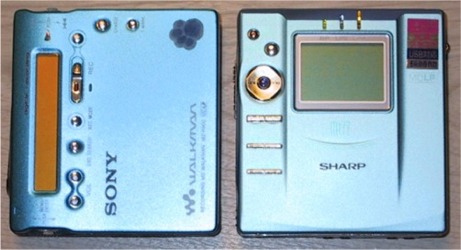
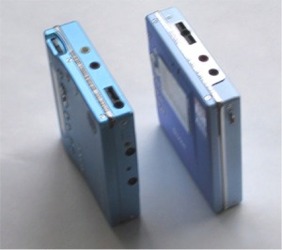
Side-by-side shots of the Sony MZ-R900 and the Sharp MT77
 Buttons
Buttons
 As the snapshot to the right shows, the buttons are all aligned on the left side of the face of the unit. The buttons are made of plastic with chrome paint.
There are no switches on the back of the unit. The HOLD function is activated by holding down the stop button for two seconds (repeat this to disable HOLD).
The record button is at the top, and has a little red dot in the center of it (which by the way does NOT light up while recording). At the center of the controls is a round disc-shaped button that controls the volume (+ and -) and tracking (|<< and >>|). There are no jog dials or jog levels, as there is on the Sony R900.
As the snapshot to the right shows, the buttons are all aligned on the left side of the face of the unit. The buttons are made of plastic with chrome paint.
There are no switches on the back of the unit. The HOLD function is activated by holding down the stop button for two seconds (repeat this to disable HOLD).
The record button is at the top, and has a little red dot in the center of it (which by the way does NOT light up while recording). At the center of the controls is a round disc-shaped button that controls the volume (+ and -) and tracking (|<< and >>|). There are no jog dials or jog levels, as there is on the Sony R900.
Unlike the newer Sony units, which delegate many of the functions to a menu-driven control system, the Sharp has dedicated buttons for display, play mode, and bass boost. The DISPLAY button will toggle the 2nd line of the text display between the different display options (track name, track time, time remaining, etc). The MODE button changes the play mode during playback, and also toggles between the recording modes while in record-standby (i.e., SP STEREO, LP2, LP4, and SP MONO). Holding down the MODE button for two seconds while the unit is stopped will get you into the SETUP menu. The EDIT menu lets you access the editing functions, but only while the unit is stopped or paused, and not during playback or recording (this is a negative when compared to Sony units, which let you perform editing functions during playback and recording).
You might notice that the buttons are extremely small, and are not spaced apart very well. This can make it difficult, as you often find yourself using your fingernails to press the correct button. Particularly, the track forward button (>>|) is wedged between the raised edge next to the display and the blue "bulge" between the two tracking buttons, so that makes it a bit hard to get that button quickly. Small button size is my biggest complaint of the MT77.
 Location of Input/Output Jacks
Location of Input/Output Jacks
All of the input/output jacks are aligned on the top edge of the unit. This allows easy access if you are using the cradle to provide power to the unit. If you have used the Sharp 831, you will find this as an improvement, as the 831 has the three I/O jacks on three different sides of the main body.

Top edge of the MT77, with the I/O jacks
 Line Out
Line Out
While there is no separate line-out jack on the MT77, setting the volume to 30 with the BASS off will set the unit at the proper line-out level. The line-level output is set at 250 mV (impedance of 10 kohms). This is equivalent to the line-level of most hi-fi units and home MD decks. In comparison, the line-out mode of the Sony R900 is set at 194 mV (10 kohms). When comparing the two in their respective line-out modes, the MT77 is noticeably louder (although the R900 still sounds great when run through a hi-fi).
 Input/Output Specs
Input/Output Specs
Here's a quick rundown of the input/output specifications, taken from the user's manual (Japanese section). For comparison purposes, I put the R900's specs next to those of the Sharp MD-MT66/77 (latest Sharp model) and the infamous Sharp MT831 (last year's model). And for those that are wondering, yes, the R900 does support plug-in power for the mic input, as most portable MD recorders do.
| Input/Output Specs |
Sharp MT77
| Sony MZ-R900
| Sharp MT831 |
| Mic Input (high) |
0.25 mV (10 kohms) |
0.25 mV (?? kohms) |
0.25 mV (10 kohms) |
| Analog Line Input |
100 mV (20 kohms) |
49 mV (?? kohms) |
100 mV (20 kohms) |
| Headphone Out |
5 mW x 2 (32 ohms) |
5 mW x 2 (16 ohms) |
10 mW x 2 (16 ohms) |
| Line Output |
250 mV (10 kohms) |
194 mV (10 kohms) |
250 mV (10 kohms) |
 Display Window
Display Window
Normally I would put the display under "Appearance and Design", but upon writing this review, I decided to give the Display a complete separate section...
Click here to go to the DISPLAY section
 Loading/Eject Mechanism
Loading/Eject Mechanism
The MT77 uses a "clamshell" loading mechanism, as opposed to a slot-in mechanism (like those used on the older Sharp 722). The OPEN slider switch is located on the left edge of the unit, and by sliding it, the lid will open slightly. You still need to pull the lid all the way open to take the disc out or put a disc in. The newer Sony units all have the "one-touch eject" mechanism, where pushing/sliding the open switch will open the lid fully and eject the disc in one motion. This is a convenience that Sharp has yet to implement.

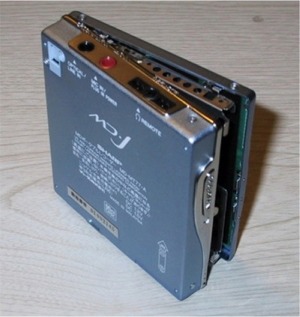
 Included Accessories
Included Accessories
The Japanese model MT77 package comes with the main unit, black cloth carrying pouch, earphones with a short cord, remote control, recharging cradle, external (AA) battery case, rechargeable gumstick battery (which comes in a plastic carrying case), RCA-to-miniplug cable, and the AC adapter (5V DC @ 800mA). Below is a picture that shows all the accessories included in the box. There is no handstrap included with the MT77, although there is a little loop for one on the top right edge of the unit.
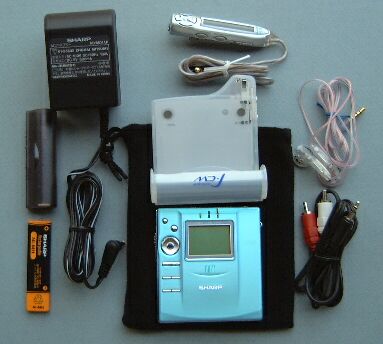
The MT77 and it's included accessories
Photo courtesy of Japan-Direct
|
|
Display | TOC
|
Quick Pros and Cons
Display is nice and large, but the two line display was implemented poorly.
|
|
 Display Window
Display Window
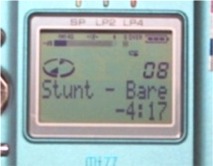 The display on the MT77's main body is nice and large, with a normal gray background. The text and indicators in the display are dark blue (as opposed to the black used on the R900). The display window on the MT77 is significantly larger that the display on the R900, but the two units basically display all of the same information (the R900 uses smaller text font and lays out the indicators more efficiently). Unfortunately there is no backlight on the main unit's display (neither is there on the R900). The contrast on the display cannot be changed (some people have asked me about this... most MD units do not have a contrast control).
The display on the MT77's main body is nice and large, with a normal gray background. The text and indicators in the display are dark blue (as opposed to the black used on the R900). The display window on the MT77 is significantly larger that the display on the R900, but the two units basically display all of the same information (the R900 uses smaller text font and lays out the indicators more efficiently). Unfortunately there is no backlight on the main unit's display (neither is there on the R900). The contrast on the display cannot be changed (some people have asked me about this... most MD units do not have a contrast control).
Finally, a manufacturer has put a two-line display on a portable! (Unfortunately, it is not implemented as well as it could have been) The first line of the display will always show the name of the disc--this cannot be changed. If the disc has no title, then it will show either music notes or a dolphin dancing across the display, depending on whether the second line is being used for anything. The second line of display can be toggled by pressing the DISPLAY button. Personally I would like to have seen a two-line display where the display mode of both lines could be changed by the user. As it is, the MT77 cannot display the track number, track name, and time simultaneously (since the first line always shows the disc title, and not the track title). To me this was just poor implementation.
 Display Indicators - Level Meter
Display Indicators - Level Meter
As the diagram above (taken from the MT77 user's manual) shows, there is a well-labeled level meter, three-step battery indicator, spinning disc symbol, and the two-line text display (each line displays 12 characters). There are two indicators for the two LP modes, which really make me think the LED's at the top of the unit were a bit redundant. The level meter at the top of the display consists of about 10 segments, and has an "OVER" indicator to let you know if your recording level is set too high. The level meter might look like it has more than 10 segments, but really three of the little vertical markings corresponds to one segment. In contrast, the level meters on recent Sony portables have 8 segments, with a ninth bar indicating "OVER". Also the level meters on Sony units are not labeled as well as they are on Sharp units.
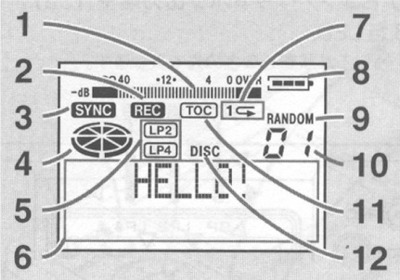
Illustration of the main unit's display, from the user's manual
 Display Modes
Display Modes
When you first insert a disc, the first line of the display will show you the name of the disc, and the second line will show the total playing time on the disc (meaning the total time that has been recorded so far). By pushing the display button, the display will show you the amount of recording time available on the disc in the current recording mode (i.e., SP, LP2, LP4, SP MONO). Note that the recording mode cannot be changed unless you are in record-standby (as opposed to newer Sony units, which allow you to toggle through the different modes by pressing the REC MODE button).
During playback, the display mode of the second line can be toggled through the following by pushing the display button [note that the track number is constantly displayed]:
- [default] Track name (Track title will scroll continuously, over and over again).
- Track time elapsed.
- Track time remaining.
{note that there is no mode to display the time remaining in the disc, as there is on Sony units}
During recording, the display of the second line shows the time elapsed in the current recording. If you push DISPLAY it will show the available time remaining. The first line still shows the disc title, even during recording!
 Text Scrolling Smoothness
Text Scrolling Smoothness
As the title of a song or disc scrolls across the display, the text kind of "stutters" across, skipping pixels, and does not scroll as smoothly as it does on Sony units. Just a minor detail, but if you're picky, you might want to know this.
|
|
Battery Details | TOC
|
Quick Pros and Cons
Sharp now uses the same gumstick battery as the Sony, although Sony manages to squeeze more life out of it. 12 hours of playback should be plenty, but the NiMH cannot be charged while you are using the unit.
|
|
 Battery Type
Battery Type
The MT77 uses a rechargeable Nickel Metal-Hydride cell which provides ~12 hours of playback on a full charge. The model number on the battery is AD-N55BT, and the specs read 1.2V, 1400 mAh. The shape and specs are identical to the Sony NH-14WM (which is the battery used by the R900, R90, and many other Sony units), and it turns out the Sony and Sharp batteries are completely interchangeable. So if you have a spare Sony gumstick lying around, feel free to use it as a spare. Both the Sharp and Sony batteries can be charged in the same chargers, so if you have an external gumstick battery charger that works in your territory (120V for the US and Canada), feel free to use that instead of the 100V Japanese adapter to charge the battery (that is, if you import the Japanese model).
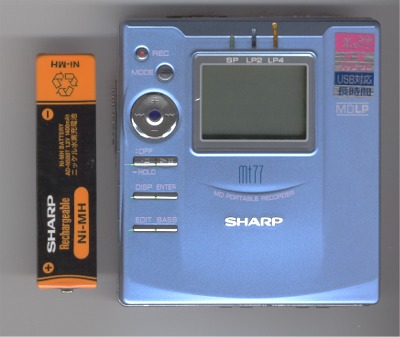
The MT77 and its rechargeable NiMH cell
 Battery Life
Battery Life
The numbers on battery life can be a little tricky, as the different modes (SP, LP2, LP4) all
have different battery lives. Often times the press releases for the newer MDLP units claim insanely high numbers for battery life, but often those numbers are for the LP4 mode, which most people will rarely use for music. Below is a pair of tables that show the battery life for both the Sharp MT77 and the Sony MZ-R900, for each of the different modes. You may note that while Sony has the higher quoted battery life, Sony also is known to greatly exaggerate the numbers on battery life, so the difference between the two units really isn't as big as it might look on paper.
Sharp MD-MT77/MT877 Battery Life
| Playback / Record |
NiMH
| AA battery
| Both batteries |
| Normal (SP) |
12 hours/ 6.5 hours |
16 hours/ 6 hours |
29 hours/ 15 hours |
| LP2 mode |
13.5 hours/ 9 hours |
19.5 hours/ 10 hours |
33 hours/ 22 hours |
| LP4 mode |
15 hours/ 11.5 hours |
22 hours/ 13 hours |
40 hours/ 30 hours |
Sony MZ-R900 Battery Life
| Playback / Record |
NH-14WM
| AA battery
| Both batteries |
| Normal (SP) |
21 hours/ 8 hours |
30 hours/ 7 hours |
53 hours/ 19 hours |
| LP2 mode |
23 hours/ 10.5 hours |
35 hours/ 10 hours |
60 hours/ 26 hours |
| LP4 mode |
26 hours/ 13 hours |
38 hours/ 14 hours |
66 hours/ 30 hours |
 Recharging Procedure - "Refresh" System
Recharging Procedure - "Refresh" System
Since there is no DC jack on the main unit, you must use the recharging cradle to recharge the battery (unless you own an external charger of another brand). On the right-hand side of the cradle, there is a white slider-switch. When the switch is up, the MT77 is in "CHARGE MODE" and the power supplied to the cradle will recharge the battery. When the switch is down, the unit is physically locked into the cradle, and the power supplied to the cradle is used for normal operation of the unit. Unfortunately, you cannot charge the battery while the unit is in use (this was possible on older Sharp units that used the longer-lasting but more expensive Lithium Ion rechargeables).
Since NiMH rechargeables inherently have a "memory-effect", Sharp has implemented a "refresh" system into the cradle which will drain a partially charged battery before recharging it, so as not to develop a "memory-effect" in the battery. Thus it is not necessary wait until the battery is fully used before recharging it (really, it is not even necessary to do this everytime, but repeatedly recharging a NiMH battery without fully discharging it can reduce its life). In my opinion, this "refresh" system is nice, but the need it seems trivial. For comparison's sake, there is no "refresh" system built into the R900's internal charger, so Sony users would be best to occasionally discharge the battery completely (note that this is something you do NOT want to do with a Li-ion cell, such as the Sharp 831's rechargeable).
 External Battery Pack
External Battery Pack
The MT77 comes with an external screw-on battery pack for a single AA-size battery. Using this will add significantly to the overall battery life. You can also operate the unit using only the external battery pack without the internal rechargeable battery. While this would seem to be common sense, the older Sharp 821 apparently did not work with the external battery pack on its own, and required the rechargeable to be inside the unit. As you can see in the photo below, the external battery pack for the MT77 is a translucent smoke-grey color. And if you're wondering, there is no DC jack on the battery pack (as there is with some Sony player-only models).
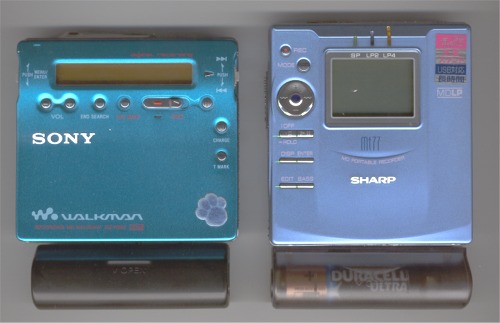
|
|
Sound Quality | TOC
|
Quick Pros and Cons
Again, the Sharp has stronger bass than Sony units, but the rest of the frequency range might sound better on a Sony unit. X-BASS is tight and mostly distortion free, but don't expect much from the included earbuds.
|
|
 Sharp Sound vs Sony Sound vs...
Sharp Sound vs Sony Sound vs...
Admittedly, comparing sound quality between different models of MD units is the most difficult thing to put into words when writing these reviews. The sound on the MT77 is excellent, the bass is deep and well rounded, and the overall sound is very "warm". When comparing Sharp units to Sony counterparts, the general consensus is that Sharps have stronger outputs with slightly deeper bass, while the Sony units sound clearer over the entire frequency (the bass on the MT77 is boomier than on the R900, but some people feel that this kind of "muddies" the mids and highs, and thus prefer the sound of Sony units). Different brands all have slightly different "signature sounds", so if you're looking for the ultimate answer to which brand "sounds better", all I can offer is that it is ultimately a choice of personal preference. If you have used Sharp MD units in the past and like the way they sound, the MT77 should not disappoint.
 Bass Boost Settings/Bass Distortion
Bass Boost Settings/Bass Distortion
The MT77 has three bass boost settings (0, 1, 2, and 3). While the newer Sony units (including the R900) allow the user to adjust both the bass and treble settings, you usually end up setting the bass and treble to levels that are very similar to the normal bass settings available on the Sharp units. To avoid bass distortion at the higher volumes, the bass level will gradually attenuate as you increase the volume above 23 (the max volume is 30).
 Included Earbuds
Included Earbuds
They suck... ^_^ Slightly better than the R900's included earbuds, serious listeners will probably not ever use them anyway. Aesthetically, they come in a transparent design that matches the cord of the remote, but I would have preferred a black cord on both. Best earbuds I have ever used are the Sony MDR-E888SP's. People have recommended the Etymonics to me, but those are a bit pricey... The Sony MDR-EX70's are okay, they provide good isolation and good bass, but I don't like the overall sound nearly as much as the 888's. Anyway, the discussion of earphones is another matter...
|
|
Remote Control | TOC
|
Quick Pros and Cons
The new remote design looks nice... but the poor button layout makes it hard to anchor your thumb when clipping it onto your shirt, and with the backlight on, the viewing angle of the LCD sucks. Overall it does its job but I liked the 831's remote better.
|
|
 Ergonomics and Remote Design
Ergonomics and Remote Design
The remote for the MT77 is different from the 831's remote, although it is not completely new (it first debuted with some Sharp player-only model well before the MT77's release). Same buttons, same functions, but redesigned layout. There is a clip on the back of the remote which you can use to clip the remote to an article of clothing. The clip is nice and strong, and you shouldn't have problems with it falling off. Interesting, the cord on the remote is not black, but clear, showing the colors of the wires inside the remote. Whether or not the user will find this aesthetically pleasing will vary from user to user.
Overall, the remote is decent, but the placement of the buttons could have been better. Particularly, the placement of the four main buttons at the head of the remote make it difficult to attach the clip (since usually, when clipping the remote to your shirt, you want to anchor your thumb right where the four buttons are...). With the R90 and MT831, I felt like Sharp had the better remote, but with both companies redesigning their remotes, I really feel like the R900's remote is the better of these two. Biggest negative with the Sharp remote is the poor button placement (you're always squeezing the remote to get a good grip and pushing buttons that you don't mean to be pushing).



Top, front, and bottom views of the MT77's remote
 Available Functions
Available Functions
Most of the functions are available from the remote. There are four buttons at the head of the remote for STOP, PLAY/PAUSE, and track forward/back (|<< and >>|). There are buttons along the edges of the remote for VOLUME, DISPLAY, PLAY MODE, and SOUND (pushing the SOUND button during recording will mark a new track). There is a HOLD switch next to the volume buttons, which (when on) prevents any accidental button presses. Recording cannot be started from the remote, unfortunately. By holding down the PLAY MODE button for two seconds, you can enter the setup menu from the remote, however you cannot enter the EDIT menu from the remote. However if you want to title a track or disc, you can enter the EDIT menu from the main unit and then use the keys on the remote to title. There is a clip on the back which is fairly strong, for clipping to a shirt.
 Remote Control Backwards Compatibility
Remote Control Backwards Compatibility
While I haven't tried it myself, it would seem that the MT77's remote should work fine with older Sharp units that support an LCD remote. Basic functionality of Sharp MD remotes has not changed much since in the last 4 years (unlike Sony), so pretty much any Sharp remote will work with any Sharp unit (with the exception of a couple of lower-end, budget-model units).
 Remote Display/Backlight
Remote Display/Backlight
The MT77's remote is equipped with a backlit LCD display. Normally the backlight will activate for 10 seconds after any button push (either on the remote or the main unit), although the backlight can be set to be always on [when running on DC power only] or always off as well. To save battery power, you can actually set the options so that the remote's LCD display completely turns off, and only turns on for 10 seconds after a button is pressed. The Sony units do not have an option to completely turn off the remote's display like this, and I believe this is the first time Sharp has put this in as an option. The diagram below shows the indicators on the remote. The text display is 6 characters long, and the two little dots on the left side labeled [1] and [7] are used as RECORD and SYNCHRO indicators, respectively. While the display serves its purpose nicely, the optimal viewing angle is unconventional. When the backlight is on, the display is not readable straight on, you have to tilt the remote away from you by about 30-45 degrees to see the display clearly (this might actually be convenient if you are wearing the remote on your shirt).
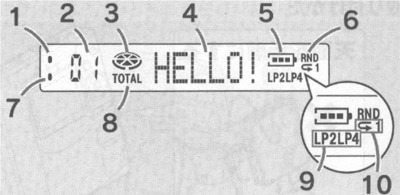
Diagram of the remote's display from the user's manual
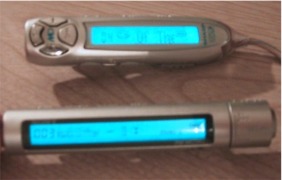 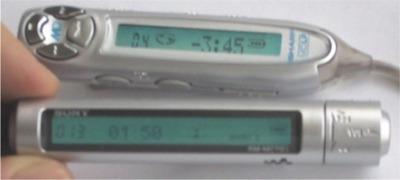
Two shots of the MT77 and R900 remotes, with the backlight on. [Please excuse the blurriness]
The shot on the left was taken at night, while the shot on the right was taken in the daytime.
 Display Modes/Capabilities
Display Modes/Capabilities
During playback, the display mode on the remote essentially mirrors the display of the 2nd line on the main unit's display. The modes cycle as follows [note that the track number is displayed constantly]:
- [default] Track name. The title will scroll continuously. If there is no name, the display will read "NoName" momentarily, then show a fish "swimming" across the display. :)
- Track time elapsed.
- Total time remaining. This is one-up on Sony, as Sony remotes do not have a display mode for track time remaining.
 Headphone Jack Location
Headphone Jack Location
The headphone jack is located on the left end of the remote. Sharp seems to have this correct, as the Sony stick remotes seem [at least in my opinion] to be upside-down. Since the cord of the headphones usually goes to the left ear first, it would seem to make sense for the headphones to plug in to the left side of the remote.
|
|
Playback and General Operation | TOC
|
Quick Pros and Cons
Not much to comment on here... although a jog dial (or something similar) would have been nice for browsing through tracks while the current track is playing (like on the R900). A track program mode would have been a nice addition, and SPEED control for all playback modes (not just MONO) would have been nice as well (but not necessary for most people).
|
|
 General Operation Notes
General Operation Notes
As the MT77 is MDLP-compatible, it will play back tracks recorded in SP (stereo or mono), LP2, or LP4 mode. There are indicators on the display to indicate whether an LP2 or LP4 track is playing, but there is no dedicated indicator to show when a mono track is playing (although the 2nd line of the display will say "mono" when showing the track time). Playback operation is fairly straightforward... push the PLAY/PAUSE button to start playing, push it again to pause. Using the |<< and >>| buttons allow you to change tracks, and holding them down will allow you to do an audible high-speed search through a track (fast-rewind / fast-forward). The STOP button doubles as a HOLD switch (hold it down for 2 seconds). There is no HOLD switch on the rear panel, as you may notice.
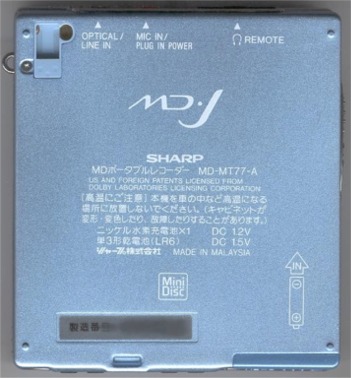
Back panel of the MT77. Note the absence of any buttons or switches
 Turning On
Turning On
When the unit is off, pushing either PLAY or REC will turn the unit on. Inserting a disc will also turn the unit on. The unit will give you a "HELLO!" greeting, then show the volume and bass levels each time it turns on. The unit will not respond to any of the other buttons while off. However you can still toggle the HOLD function on/off by holding down the STOP button for two seconds, even if the unit is off.
 Shutting Off
Shutting Off
By pushing the stop button when the unit is already stopped will shut it off. Or if the unit is stopped and you leave it alone for two minutes, it will shut off automatically. Whenever the unit shuts off, it gives you a "GOOD BYE!" message.
 Changing Tracks
Changing Tracks
The Sony R900 has the nice ability to browse through the tracks on the disc during playback of the current track... (This is done by using the R900's left jog lever to search tracks, then pushing the lever in to jump to the selected track... this allows the music to keep playing while you are looking for the next track to play). The last Sharp unit that had such a feature was the 722, and unfortunately there is no such feature on the MT77. So if you want to jump to a specific track, you have to do it with the |<< and >>| buttons the long way.
On the MT77 (as with any Sharp unit), if you are on the first track of the disc, you can push the |<< to go the last track... likewise, if you are on the final track of a disc, you can push >>| to jump to the first track. You can't do this on a Sony unit, unless it is in REPEAT mode.
 Playback Functions/Modes
Playback Functions/Modes
The playback modes remain the same from previous Sharp units. By pushing the MODE button, the available play modes are NORMAL, RANDOM, RANDOM-REPEAT, REPEAT, and 1-REPEAT. There is no track program mode, as there is on the R900. There is also an INTRO PLAY function, which is not on any current Sony MD unit. With the exception of INTRO PLAY, the play modes can be changed during playback, or while the unit is stopped. The INTRO PLAY mode can only be selected while the unit is stopped.
- Normal mode plays through the disc and stops after the last track.
- RANDOM and RANDOM REPEAT are the shuffle modes. RANDOM will play through all of the tracks on the disc in random order and stop after the last track is played. RANDOM-REPEAT will continue the shuffle procedure over and over again. However every track will be played once before any tracks are repeated, unlike with the R900's Shuffle-Repeat mode. There is an audible interruption as this mode switches from track-to-track, so the transitions are not seamless (as they are on the Sony's shuffle modes).
- REPEAT plays through the disc and loops back to the beginning after completing the disc... over and over again.
- 1-REPEAT plays the selected track over and over again, until you push stop or until the battery runs out. There is an audible interruption at the end of the track, as the unit loops back to the beginning, so it is not possible to do smooth music loops on the MT77 (as with all Sharp portables). If you want smooth music loops, you'll have to go with a Sony (or maybe even an Aiwa).
- INTRO PLAY is new on the MT77 (one of the few additions from the 831). By holding down the PLAY button for two seconds while the unit is stopped, you will enter INTRO PLAY mode, where the first 5 seconds of each track are played in order. Again, there is an audible interruption as this mode switches between tracks, so the transitions are not seamless.
 FAST Playback
FAST Playback
There is no SPEED/PITCH control on the MT77 as there is on the R900, however the MT77 (just like all Sharp units) will let you play back a mono track at double speed. To do this, push the ENTER button while the track is playing. You cannot do this with tracks that are recorded in SP stereo or either of the LP modes, only with tracks recorded in SP MONO. For reference, the R900 allows you to adjust the playback speed from 80-110% of normal speed, for any of the SP and LP modes.
 Track Access and Read/Write Times
Track Access and Read/Write Times
This is something I paid attention to when Sony released the MZ-R90. People who bought the R90 were amazed at how Sony squeezed 12 hours of playback time from the 1400mAh NiMH, but then started to realize how incredibly S-L-O-W the unit operated (the Sharp 831 was not nearly as snail-paced as the R90, but Sony improved their read/write speeds in the R900). Below is a table that outlines the read/write times for the MT77, the R900, and the classic 1997-98 Sony model MZ-R50 (the fastest unit ever made).
| Read/Write/ Startup Times |
Sharp MT77 |
Sony MZ-R900 |
Sony MZ-R50
(the classic) |
Time to play
FROM SHUTOFF |
7-9 seconds |
4-7 seconds |
2-3 seconds |
Time to play
FROM STOP
(while unit is still on) |
2 seconds |
instantaneous |
instantaneous |
| Changing Tracks |
1-5 seconds
(depends on physical location of next track, helps if Power Save is OFF) |
1-5 seconds
(depends on physical location of next track) |
1-2 seconds |
Time to detect
NO DISC |
12 seconds |
3-4 seconds |
instantaneous |
| Average TOC EDIT times |
9 seconds |
8 seconds |
3-5 seconds |
 Fast Forward/Rewind Smoothness
Fast Forward/Rewind Smoothness
The fast-forward/rewind cueing on the MT77 is fairly smooth, definitely an improvement over the 831, and finally on-par with rival Sony units. When you hold in the |<< or >>| to start the high-speed cueing, the cueing will start almost instantaneously if the Power Save option is OFF {if it is on, it can sometimes take a couple of seconds, as it does on the R900}. As with Sony units, the high-speed cueing is faster if you pause the playback first and then hold |<< or >>| (although not quite as fast as on the Sony units... on the MT77, it takes about 3 seconds to speed through each minute of a track. So to fast-forward through the first 2 minutes of a track, it would take about 6 seconds, while paused).
 Smooth Music Loops and Seamless Shuffle Transitions
Smooth Music Loops and Seamless Shuffle Transitions
This is one area where Sony always has the best of Sharp. Both the 1-REPEAT and RANDOM (aka Shuffle) play modes on the MT77 have audible gaps when moving from track to track (although not the case when playing sequentially in the normal or normal-repeat modes).
 Auto Play
Auto Play
When you insert a write-protected disc into the MT77, it will start playing automatically. This however can be turned off in the options menu, and only affects discs that are write-protected.
 Motor Noises (or lack of!)
Motor Noises (or lack of!)
The one really amazing thing about the MT77 is that it makes almost no motor noises. During operation the unit is extremely quiet, which is in stark contrast to recent Sony units, and something that Sony could definitely take some notes on. The lack of audible motor sounds makes it much more convenient to do microphone recordings with the mic placed near the MD unit, as you don't have to worry about the mic picking up the "whirring" of the unit.
 Anti-Shock Memory
Anti-Shock Memory
The MT77 has the standard issue 40 seconds anti-shock memory... which doubles and quadruples for the LP2 and LP4 modes. To elaborate, the shock memory is 40 seconds in SP mode, 80 seconds in LP2 mode, and 160 seconds in LP4 mode. If the POWER SAVE option is on (as it is by default), the MT77 will quickly fill the buffer with 40 seconds of music (in SP mode), then rest for about 30 seconds... and do this repeatedly. If the POWER SAVE option is OFF, then the MT77 will read the disc continuously, keeping the buffer full. This consumes more battery power, but is better if you are using the MT77 while exercising.
 Pulling the plug during playback...
Pulling the plug during playback...
If you are operating the MT77 in the cradle with the AC adapter plugged in, and then pull out the plug during playback, the unit will automatically switch to battery power and continue playing without stopping. The same applies if you pull out the plug while recording. Sony units will stop playback if you pull out the plug, but continue normally if you pull it out during recording.
|
|
Recording | TOC
|
Quick Pros and Cons
Aside from strong sound quality, Sharp's strong point has always been ease-of-recording, and extensive options that are not available on Sony units (particularly analog and mic synchro options, and the ability to turn off the level-sync auto-trackmarks. But there still is no time/date stamp, and you still have to wait for the unit to fully read a disc's TOC before it starts recording.
|
|
 General Recording Notes
General Recording Notes
Ease-of-recording is where Sharp has always held the biggest advantage over the Sony units, and that hasn't changed much with the newest units from both companies. Despite the fact that Sony has an option to automate END SEARCH in its newest portables, Sony still has a long way to go to catch up with the recording options that Sharp offers (although the automatic END SEARCH was definitely a monumental improvement for Sony). The MT77 has the usual synchro and auto-tmark functions, but unfortunately Sharp has gotten rid of the fader that was on the 831.
Pushing the REC button will enter the MT77 into record-standby. While you are in standby, you can monitor the level of the input, change the recording mode (this is the only time you can change between the SP or LP modes), and set the synchro and/or auto-trackmark functions. The recording level can be changed during standby or during the actual recording (which Sony units do not allow). To actually begin recording, you need to push the PLAY/PAUSE button while in standby. Sony units begin recording as soon as you slide the RECORD switch, and require you to pause the recording and go through a slew of menu options before you can change the recording level. If you do a lot of live recordings that require you to adjust your input levels on the fly, you'll probably find the Sharp units more to your liking. There is still no AGC (Automatic Gain Control) on the MT77, as there is on Sony units.
 Recording Audio Files from your computer (MP3-to-MD recording)
Recording Audio Files from your computer (MP3-to-MD recording)
If you need a way to record MP3's (or other types of audio files from your computer) onto minidisc, you have a few options. The first thing you should know is that any MP3-to-MD recording has to take place in realtime (in other words, single speed). So if you're looking for an alternative to an MP3 player, this is probably the biggest drawback of the minidisc format. Perhaps someday either Sony or Sharp will design a bi-directional USB interface that will allow high-speed transfers of audio files, but for now, that is just a faraway dream.
If you're not satisfied with the sound quality on the output of your soundcard, there are a number of USB-to-optical devices (Xitel MD Port, Novac Catchsound, to name a couple) that provide a connection from your computer to your MD recorder for MP3 transfer, and most of these devices can be used on any MD recorder (with a few exceptions). I have put together a short guide on USB-to-optical converters that might help you get started... click here. You could also just hook up an analog cable from your soundcard to your MD recorder (this is the cheapest and simplest solution); if you don't know much about how to do this, Gerald Tomyn has put together an excellent guide that covers the various methods of recording MP3's onto minidisc. His page is located at: http://members.nbci.com/ntomyng/index.htm.
Sharp also has a very cool (but expensive, and not included) optional PC link specifically designed for the MT77. The link (model# AD-PCR2) connects to a USB port on your computer, and provides an optical digital audio connection to the input of the MT77. Another cable connects from the link kit to the remote jack of the MT77, and the included software program allows you to transfer audio files (MP3, wave, etc) from the computer and record them onto MD (but not from MD to the computer... only from PC to MD). The software also controls the MT77 and allows you to enter track and disc titles via the graphical interface with your keyboard (which the Xitel MD-port units cannot do). A schematic of the connection kit is below... If you want the PC link, you'll have to search around for it yourself, and it is only available in Japan. Model number is Sharp AD-PCR2, and MSRP is Y18000 (roughly $150-$160 US). The software is in Japanese, but [supposedly] it does function correctly on US Windows. Don't know if perhaps Sharp will release this PC Link in the US with the MT77 this summer... Information on the Sharp AD-PCR2 (including screenshots of the control software) is available on the Sharp Japan website, at http://www.sharp.co.jp/sc/eihon/mdmt77/text/link.html [Japanese only].
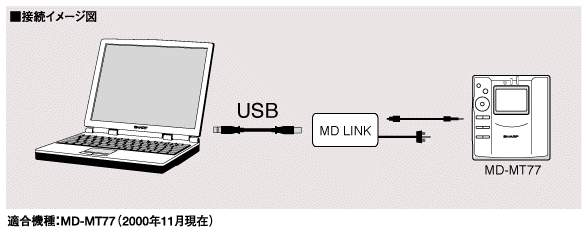
Schematic of the Sharp MT77 PC Link kit.
More info at http://www.sharp.co.jp/sc/eihon/mdmt77/text/link.html
 END SEARCH?
END SEARCH?
Recordings on the MT77 always start from the end of the disc, without requiring the user to push an END SEARCH button (as is required on pre-R900 Sony units). If you want to overwrite currently existing material, you can play the disc and pause it at the point that you want to start recording, then push REC. The unit will ask you to push ENTER if you really want to do this, as everything after that point will be erased immediately. For instance, if you have 70 minutes of music recorded on an MD, and you choose to start recording from 5 minutes into the disc, the last 65 minutes will immediately be erased, even if you only record for a few seconds. This is very different from Sony units, which will only erase roughly the amount of time that you recorded (minus a few seconds, due to the way the disc fragments work).
 Switching Recording Modes
Switching Recording Modes
To switch between the different recording modes (SP STEREO, LP2, LP4, SP MONO), you need to put the unit in to record-standby and push the MODE button. You cannot change the record mode while the unit is stopped, as you can on the R900. This can be inconvenient if you want to quickly compare how much recording time is available to you in each of the different modes, as you must first enter record-standby.
 Recording Immediately After Changing Discs
Recording Immediately After Changing Discs
This is one significant advantage that the Sony units hold over the Sharps. On the MT77 (as with any Sharp unit), when you insert a disc and push RECORD, the user must wait for the unit to read the TOC of the disc (which takes about 8 seconds) before the recording actually starts. If you are recording a live event and are in a rush, this can be bad news. In contrast, Sony units begin recording almost as soon as you slide the record switch (there is actually about a one-second delay, but very slight), even while the TOC is being read. This is accomplished by storing the first few seconds of the input signal into the buffer, then writing it after the TOC has been read. This will prevent you from losing the first 7 or 8 seconds of a recording if you are in a hurry, or changing discs during a concert, or lecture, or something like that.
 Adjusting Recording Levels - Automatic Gain Control (AGC)
Adjusting Recording Levels - Automatic Gain Control (AGC)
All Sharp units (the MT77 included) allow you to change the recording volume level during the actual recording (instead of forcing the user to pause, as with Sony units... this is one of the biggest reasons for choosing Sharp over Sony). Simply use the |<< and >>| buttons to adjust the input level up and down either while in standby, or while recording. Input levels can be adjusted for any of the inputs (older models--MT821 and older--did not allow you to adjust the recording levels of a digital recording). There is no automatic gain control (AGC) for the analog line/mic inputs as there is on the Sony units, so recording levels do need to be monitored and set appropriately. Automatic Gain Control (AGC) normalizes the input signal--"squashing" the signal if it gets too high, and boosting it if it gets too low. Sharp units do not have AGC, and force the user to set the recording levels manually so that they do not clip. This is a plus for Sony units, as the AGC allows for making a casual recording with minimum hassle. (Note that for the highest quality recordings, you will want to turn off the AGC on Sony units, but it is a nice convenience to have for casual recording situations)
- Digital input levels can be adjusted from -12dB to +12dB in 1dB increments. 0dB is the default, and depending on the D.L. (digital level) mode that you have specified in the SETUP menu, this level will either reset to 0dB after every recording, or stay at the current setting. The Sony models only show a horizontal bar when changing recording levels, and always resets to the default setting after each recording
- Analog line input levels are adjustable from 0 - 30 (sorry, I don't know the actual gain figures... but default is roughly 20). The display shows you the number, and not a horizontal bar like on Sony units. This level is remembered after each recording (likewise on Sony units).
- Mic input levels are adjustable from 0 - 30, with 0-20 corresponding to the lower sensitivities (louder environments), and 21-30 corresponding to the higher sensitivities (for quieter settings). There are no preset levels for HIGH and LOW as there is on the Sony -- slight inconvenience for novices(?) -- but the levels can easily be changed, so this shouldn't be too much of an issue.
 SYNC Recording
SYNC Recording
The ENTER button doubles as the SYNC button, although it is not visibly labeled as such. Synchro recording modes are available for all three inputs (optical, line, and mic) on the Sharp units. To enter the SYNC recording mode, put the unit into record-standby, and push the ENTER button.
- When recording from the optical or line input, the recording will then begin automatically when an audio signal is first detected, without you having to push the PAUSE button. Also, the unit will re-enter standby mode automatically whenever there is no signal detected for 3 seconds, then restart automatically when a signal is detected (a new track is marked whenever this happens). Interesting, Sharp seems to have done something new to the MT77 because digital synchro recording even works when recording from the optical output of a computer's soundcard (well, at least with my soundcard--Aureal Vortex... I can't guarantee that synchro recording works with all soundcards, although I wouldn't think there should be any problems). Most MD recorders (including the R900 and any older Sharp or Sony unit I've ever tried) did not perform digital synchro-start properly when recording from a soundcard's optical output (when using digital synchro on other units, recording would start as soon as you turn on SYNC, even if there is no source playing).
- When recording from the mic input, you can choose between MIC SYNC HIGH and MIC SYNC LOW. This will determine the decibel level at which the auto-start and auto-pause is triggered (-24dB for SYNC H, and -12dB for SYNC L). This is a very nice feature that is useful for automatically pausing out large portions of near-silence when you're recording a lecture.
Of course you can always record without using the SYNC function, if you need to preserve the silent portions of a recording. Sony units only have synchro recording for the optical input (auto-start and auto-pause), but not for the analog line-in and mic inputs. Why not? This seems like such a useful feature for analog recordings, but Sony just seems to be unwilling to implement it. Huge advantage for Sharp in this department.
 Auto Track Mark Modes
Auto Track Mark Modes
The MT77 has a set of auto track-mark modes for the different inputs, which can be used in conjunction with synchro recording.
- For optical and analog line-in recordings, the MT77 has an AUTO-MARK feature which can be turned on or off (press the EDIT button while recording to toggle this setting). When this feature is ON, the MT77 will automatically place a track mark after a low-level segment of 2 seconds or more. AUTO MARK is ON by default, and if even if you turn it OFF, it will revert back to the default setting after each recording. And if recording optically from a CD player or another MD player (but not from a computer's soundcard), the MT77 will always mark a new track whenever the track number on the source changes, even if AUTO MARK is turned OFF (almost all MD recorders do this, including the R900).
- For mic recordings, you can set the unit to start a new track automatically every 3, 5, or 10 minutes. Pushing the EDIT button while recording will toggle through the different time settings, or turn it off altogether (it is off by default).
In contrast, the Sony R900 automatically marks a new track after a low-level segment of 2 seconds or more when recording from the analog line-in (does not work with the optical or mic inputs), and this auto-marking cannot be turned off on Sony units. In addition, the R900 has a TIME MARK feature which will automatically place a track mark at increments of 5, 10, or 15 minutes. The Sony TIME MARK feature only works with the mic-in and line inputs, and not with the optical input.
 Time/Date Stamp (or lack of)
Time/Date Stamp (or lack of)
Sharp units do not have time/date stamp, and unfortunately the MT77 is no different. Higher-end Sony portables (R900 included) do stamp recordings with the exact time/date of recording. This is one feature I really wish Sharp would implement, but they have yet to deliver. To be fair to Sharp however, this is only one of two advantages that I think Sony holds when it comes to recording (the other being recording immediately after inserting a disc without losing the first few seconds).
 LP Stamp
LP Stamp
When you record in either LP2 or LP4, the MT77 will automatically append "LP:" at the beginning of the track title. However, the "LP:" will not show up while playing on the MT77, it will only show up when playing that track on an older, non-MDLP compatible unit. This automatic "LP-stamping" cannot be turned off on the MT77 (nor can it be turned off on the R900... however some Sony home decks will allow this as an option). Interestingly, the MT77 will not allow you to remove the "LP:" from the beginning of an LP track, as the R900 will (the "LP:" doesn't even show up while editing, as it does on the R900). The "LP:" does count towards the total number of characters that you can use on the disc, so if run out of text space and want to erase these, you'll have to use another unit to do so.
 Pulling The Plug during RECORDING
Pulling The Plug during RECORDING
If you cut the DC power source during recording, the unit will automatically switch to battery power without interrupting the recording. If there is no battery inside the unit... you might be in trouble. Sometimes you can restore the power source and the unit will automatically write the TOC when you plug it back in, but this is not always the case.
|
|
Editing | TOC
|
Quick Pros and Cons
The MT77 still does not let you title during playback. Navigating through the EDIT menus can be a bit cumbersome since you can't use the |<< and >>| to navigate through the editing options. The optional USB link kit is great and can be used to perform all editing functions, but it's expensive and most people may never buy it. Ease-of-editing goes to the R900.
|
|
 Editing During Playback/Recording, Edit Menus
Editing During Playback/Recording, Edit Menus
Generally, editing has been easier on Sony units than on Sharp units. To name or edit a track on the MT77, you must first pause the playback, or stop the unit. Track titling cannot be done during playback, which can be a drab pain if you do a lot of titling on your portable. Tracks cannot be titled during recording, you must wait until after a track is recorded to title it. Newer Sony portables allow tracks to be titled during playback and recording.
Pushing the EDIT button repeatedly will cycle through the available functions, and pushing ENTER will select that operation (personally, I think it would make more sense to push EDIT to enter the menu, then use the |<< and >>| buttons to cycle through the options). If you edit a track during play/pause, playback will revert to the beginning of the track (instead of staying at the point of the track that it was paused at).
When stopped, the available EDIT functions are DISC NAME, ALL ERASE, and NAME STAMP.
While play/paused, the available functions are DIVIDE, COMBINE, ERASE (track), MOVE, TRACKNAME, ALL ERASE, and NAME STAMP.
 Dividing Tracks
Dividing Tracks
To divide a track on the MT77, you must pause the track at the desired divide point, enter the EDIT menu and select DIVIDE, and push ENTER. There is no separate TRACK MARK button, as there is on Sony portables. There are no problems with the precision of the DIVIDE operation, as there are on the newer Sony units.
 Disc/Track Titling
Disc/Track Titling
Titling is done on the MT77 by scrolling through the alphabet with the |<< and >>| buttons, and pushing ENTER to "type" the characters. The MT77 scrolls through the character sets a little faster than the Sony units, and when you enter a character on the Sharp unit, the cursor stays at that character instead of going back to the beginning of the alphabet... meaning if you want to enter two "t"'s consecutively, you can just scroll to the letter "t" and push ENTER twice, instead of having to enter the first "t", then starting back at the letter "a" again. The DISPLAY button toggles through the different character sets (Japanese kana, Roman Uppercase, Lowercase, and numbers/symbols). Again, tracks can only be titled while the playback is paused--meaning you cannot title a song while you are listening to it. If you opt to get the Sharp PC link (AD-PCR2), you can use just open up the software and title tracks with your keyboard... if you're willing to drop down $150 US.
 Name Stamp
Name Stamp
NAME STAMP is a cool feature that lets you transfer the disc and track titles from one disc to another, if the two discs have the same number of tracks. This can be useful and save you a lot of time if you like making copies of MD's for people, and you don't want to bother with manually titling every copy. This function is not actually done during recording, but afterwards as a separate process (so you can use NAME STAMP with a disc that was recorded on another unit, it doesn't actually have to be recorded on the MT77).
 TOC updates (and how to cancel them)
TOC updates (and how to cancel them)
When you finish performing an editing task, the MT77 will update the TOC when you shut the unit off, and not just when you stop playback (like Sony units do). If you have made any changes to the TOC, the TOC indicator on the display comes on, and the OPEN slider will lock, so that you are unable to remove the disc) until you shut the unit off and update the TOC. If you remove the battery from the unit before it has a chance to write the TOC, you will cancel any changes made since the last update (just like on Sony units)... however the unit does remain locked until you turn it back on (but the TOC changes will be undone when it does turn back on). Note that while you can use this method to undo an editing change, you cannot undo a recording. If you pull out the battery after you record but before the TOC is written, the MT77 will write the TOC as soon as you restore the power source.
|
|
Setup Menu Options | TOC
|
Quick Pros and Cons
It is very nice that Sharp allows the user to change these settings... however the settings for the LED and remote backlight really should be separate from one another.
|
|
By holding in the MODE button for two seconds (while the unit is on), you will enter the SETUP menu. Here you can change various settings (BEEP, A-PLAY, AUTO Psave, D.L.MODE, and LIGHT) according to your preferences. Using the |<< and >>| keys will navigate between the different settings, and pushing MODE will toggle that setting. Pushing the STOP button will get you out of the SETUP menu. As the English section of the Japanese user's manual appears to do a poor job of explaining these options, the following is a rundown of the various SETUP options:
 BEEP -- ON/OFF
BEEP -- ON/OFF
As is standard with most portables nowadays, the unit will "beep" whenever a button is pushed (either on the main unit or on the remote). This beep is fairly low-level, and almost inaudible when playing back through a hi-fi unit.
 A-PLAY (Auto Play) -- ON/OFF
A-PLAY (Auto Play) -- ON/OFF
When this option is turned ON, it will automatically start playing a disc when you insert it, without you having to press the PLAY button. As with previous Sharp units (and Sony home decks), this only works with discs that are write-protected. By default, this option is ON.
 Psave (PowerSave) -- AUTO/OFF
Psave (PowerSave) -- AUTO/OFF
When this option is turned on AUTO, the unit will cut back on
keeping the 40 second anti-shock buffer full in order to save
battery power. If you like to use your MD unit in active situations
(jogging or biking, for instance), you would be best to turn this
option OFF, so that the unit will continuously read the disc and keep
the buffer full. By default, this option is on AUTO Psave.
 D.L. MODE (Digital Recording Level Mode) -- 1 or 2
D.L. MODE (Digital Recording Level Mode) -- 1 or 2
This option is probably the most confusing for importers, as it is not explained at all in the English section of the manual (831 owners had the same gripe). This option affects whether the digital recording level is remembered after each recording, or if it resets to 0 dB after every recording. D.L.MODE 1 remembers the digital recording level, whereas MODE 2 will default back to 0 dB every time you push STOP to end a recording. By default, this option is set to D.L.MODE 1.
 LIGHT (LED/remote display operation) -- NORM, ALL, OPER, OFF
LIGHT (LED/remote display operation) -- NORM, ALL, OPER, OFF
On the top of the unit are three LED's, labeled SP, LP2, and LP4. Their primary purpose is to let the user know the format of the current track, but their presence seems to be trivial, as there are indicators in the display window which indicate both LP2 and LP4. Some people might think of the LED's as a waste, some might think that they're "cute". In any case, the operation of the lights can be changed in the SETUP menu. Here is a rundown of the different available settings:
| LIGHT setting |
Power on |
During Playback |
Changing tracks/ high speed cueing |
During Recording |
Remote Display |
Remote Backlight |
| NORMAL |
LED's blink randomly while reading TOC |
LED for appropriate mode blinks once every three seconds |
LED's blink from left to right if going forward, or right-to-left if going back |
LED for mode blinks twice ("blink-blink") every three seconds |
Always on |
On for 10 seconds after a button push |
| ALL |
LED's each blink once, from left to right |
LED for appropriate mode is constantly on |
LED's blink from left to right if going forward, or right-to-left if going back |
LED for appropriate mode is constantly on |
Always on |
Always on [when powered by AC adapter/cradle. Otherwise on for 10 seconds after a button push |
| OPER |
LED's each blink once, from left to right |
OFF |
LED's blink from left to right if going forward, or right-to-left if going back |
LED for mode in use stays on for 10 seconds after a button push |
On for 10 seconds after a button push |
On for 10 seconds after a button push |
| OFF |
OFF |
OFF |
OFF |
OFF |
On for 10 seconds after a button push |
Always OFF |
You should note that the LED settings and remote display/backlight settings cannot be changed independently of each other. So if you want the LED's off with the remote backlight always on [with AC power], you will be disappointed. Personally I really think Sharp should have made the LED settings and remote display settings separate in the setup menu.
|
|
Links / Miscellaneous | TOC
|
|
 MD Links
MD Links
If you are looking for more info on these fantastic MD units, here are some good sources to get you started:
• The Minidisc Community Page--The mecca of MiniDisc... If you're new to the technology, quite frankly, this is where it all begins. Check the equipment browser for info on the MT77.
• The Korean Minidisc Page--Great MD site that is primarily in Korean, worth looking through even if you can't read Korean.
• The T-Station--Great MD site, full of news, user reviews, and evaluations of online retailers, which is very useful if you want to do some research on who to order from.
• T's MiniDisc Recorder
Comparison Table (MDCT) Page--Great page with plenty of info on pretty much all current portable MD recorders, players, and boomboxes. Arranged in easy-to-browse tables.
• The Minidiscussion Message
Boards--Popular place to post/find info about MD units, etc.
• Guide to recording music from your computer to Minidisc--Great page put together by Gerald Tomyn (aka, Mike Rofone). If you're looking for info on how to record MP3's (or other computer audio file formats) onto your MD's, this page has all the info you need.
• Japan-Direct-- Japan-based retailer of MD portables and other fine electronics. Excellent service (both pre and post-transaction), one of the best warranty policies, and extremely quick delivery times. I've ordered goods from many places and Japan-Direct has never disappointed me.
• The Sound Professionals-- Great source of microphones to suit a wide range of live recording needs. If you're looking for a good set of mics for your MD recorder, this is a pretty good place to start.
• Minidisc Holders-- High Quality MD racks constructed in Montana. Different sizes and colors available, and great for fashionable storage of your minidisc collection.
|
|
Author Contact Info | TOC
|
If you have any questions of comments, or notice that I may have left
something out, or if there are any broken links, if you want to link this
page to your site, etc... don't hesitate to contact me at hacienda@mail.utexas.edu.

| |
This page is Copyright © 2001 by Brian Y. Youn, all rights reserved.

visitors since March 23, 2000
Free counters provided by Honesty
Communications.
|
|





















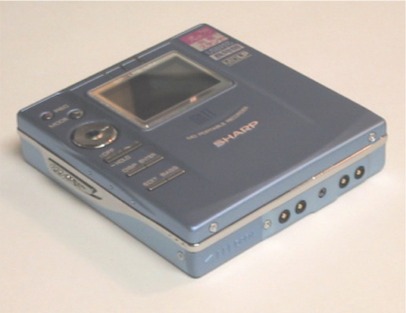
 Changes from previous Sharp models
Changes from previous Sharp models
 Sharp has given the MT77 a very slick design that most people either love or hate. As usual, the unit looks smaller in person that it does in photos and snapshots. The display window is nice and large, and has a two-line text display, which is a nice addition (unfortunately Sharp did not implement this as well as they could have, as only the 2nd line can be changed by the user, and the first line ALWAYS shows the disc name). All of the buttons are aligned on the left side of the face, and as you can probably see, the buttons are small. Normally I am not one to complain about the size of buttons on portables (I thought the size of the buttons on the R55 and R900 were just fine), but the buttons on the MT77 are small and not spaced out very well. The unit opens on the left edge, which is where the disc is inserted (a bit awkward unless you're left-handed). The door must still be pulled open after you slide the eject lever--no "one-touch eject" on the Sharps just yet... Input/output jacks are on the top edge, while the rechargeable battery hatch and external battery case connections are on the bottom edge of the main body. There is nothing on the right-hand edge save for the small metal loop for an optional hand strap (not included with the MT77 strangely).
Sharp has given the MT77 a very slick design that most people either love or hate. As usual, the unit looks smaller in person that it does in photos and snapshots. The display window is nice and large, and has a two-line text display, which is a nice addition (unfortunately Sharp did not implement this as well as they could have, as only the 2nd line can be changed by the user, and the first line ALWAYS shows the disc name). All of the buttons are aligned on the left side of the face, and as you can probably see, the buttons are small. Normally I am not one to complain about the size of buttons on portables (I thought the size of the buttons on the R55 and R900 were just fine), but the buttons on the MT77 are small and not spaced out very well. The unit opens on the left edge, which is where the disc is inserted (a bit awkward unless you're left-handed). The door must still be pulled open after you slide the eject lever--no "one-touch eject" on the Sharps just yet... Input/output jacks are on the top edge, while the rechargeable battery hatch and external battery case connections are on the bottom edge of the main body. There is nothing on the right-hand edge save for the small metal loop for an optional hand strap (not included with the MT77 strangely).



 As the snapshot to the right shows, the buttons are all aligned on the left side of the face of the unit. The buttons are made of plastic with chrome paint.
There are no switches on the back of the unit. The HOLD function is activated by holding down the stop button for two seconds (repeat this to disable HOLD).
The record button is at the top, and has a little red dot in the center of it (which by the way does NOT light up while recording). At the center of the controls is a round disc-shaped button that controls the volume (+ and -) and tracking (|<< and >>|). There are no jog dials or jog levels, as there is on the Sony R900.
As the snapshot to the right shows, the buttons are all aligned on the left side of the face of the unit. The buttons are made of plastic with chrome paint.
There are no switches on the back of the unit. The HOLD function is activated by holding down the stop button for two seconds (repeat this to disable HOLD).
The record button is at the top, and has a little red dot in the center of it (which by the way does NOT light up while recording). At the center of the controls is a round disc-shaped button that controls the volume (+ and -) and tracking (|<< and >>|). There are no jog dials or jog levels, as there is on the Sony R900.
 The display on the MT77's main body is nice and large, with a normal gray background. The text and indicators in the display are dark blue (as opposed to the black used on the R900). The display window on the MT77 is significantly larger that the display on the R900, but the two units basically display all of the same information (the R900 uses smaller text font and lays out the indicators more efficiently). Unfortunately there is no backlight on the main unit's display (neither is there on the R900). The contrast on the display cannot be changed (some people have asked me about this... most MD units do not have a contrast control).
The display on the MT77's main body is nice and large, with a normal gray background. The text and indicators in the display are dark blue (as opposed to the black used on the R900). The display window on the MT77 is significantly larger that the display on the R900, but the two units basically display all of the same information (the R900 uses smaller text font and lays out the indicators more efficiently). Unfortunately there is no backlight on the main unit's display (neither is there on the R900). The contrast on the display cannot be changed (some people have asked me about this... most MD units do not have a contrast control).
